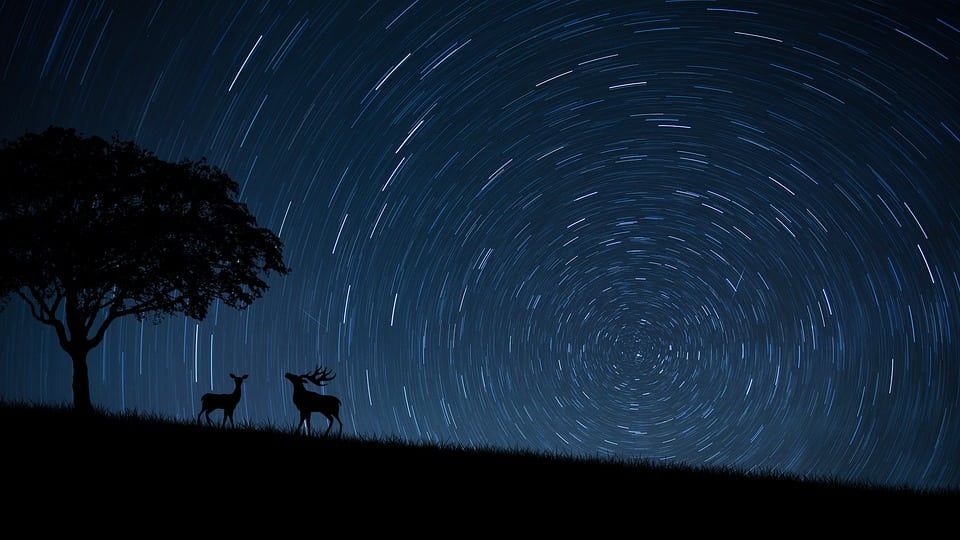
Animals are adopting the night life… just like in the days of the dinosaurs, according to new research.
Human activities including hunting, hiking and transport is turning them from sky larks into night owls, according to new research.
It harks back to the days of early mammals that evolved night time vision to avoid the giant reptiles that roamed Earth more than 100 million years ago.
The phenomenon is happening again as they use the protection of darkness to hide from people.
They range in size from the little common possum to the wild boars of Spain and the elephants of Africa.
The study of 62 species across six continents found mammals were 1.36 times more nocturnal in response to human disturbance.
This means an animal that naturally split its activity evenly between the day and night increased its nighttime activity to 68 percent around people.
The finding was consistent across carnivores and herbivores of all body sizes greater than 1 kg (2.2lbs).
They also included the red brocket deer of Argentina, the coyote of California, the sable antelope of Zimbabwe and the tiger of Nepal.
Small mammals were not included as larger animals need more space and are more likely to be in competition with humans.
Lead author Kaitlyn Gaynor, a PhD candidate at the University of California, Berkeley, said: “While we expected to find a trend towards increased wildlife nocturnality around people, we were surprised by the consistency of the results around the world.
“Animals responded strongly to all types of human disturbance, regardless of whether people actually posed a direct threat, suggesting our presence alone is enough to disrupt their natural patterns of behaviour.”
Night-time vision evolved in early mammals during the age of the dinosaurs.
The photoreceptors that help us see in dim light developed from colour detecting cone cells in Jurassic mammals, according to genetic evidence.
The evolution of night-time vision is regarded as a landmark event in the rise of mammals.
A nocturnal lifestyle allowed the first of their kind to avoid predatory dinosaurs.
Now human activity is causing the planet’s mammals to flee daylight for the protection of night
The study published in the journal Science is the first to quantify the global effects of human activity on the daily activity patterns of wildlife.
Its results highlight the powerful and widespread process by which animals alter their behaviour alongside people, creating a more nocturnal natural world.
Ms Gaynor said: “Catastrophic losses in wildlife populations and habitats as a result of human activity are well documented.
“But the subtler ways in which we affect animal behaviour are more difficult to detect and quantify.”
Her team pooled data from across the world to look for global shifts in the timing of daily activity of mammals in response to humans.
The information was collected by remotely triggered cameras, GPS and radio collars and direct observation.
For each species in each study site, the authors calculated the difference in animal nocturnality under low and high human disturbance.
The pattern held across different types of activities including hunting, hiking, mountain biking and infrastructure like roads, residential settlement and agriculture.
Ms Gaynor said: “While we expected to find a trend towards increased wildlife nocturnality around people, we were surprised by the consistency of the results around the world.
“Animals responded strongly to all types of human disturbance, regardless of whether people actually posed a direct threat, suggesting that our presence alone is enough to disrupt their natural patterns of behaviour.”
Senior author Justin Brashares, a professor in the Department of Environmental Science, Policy, and Management, said the consequences can be seen through contrasting lenses.
He said: “On the positive side, the fact wildlife is adapting to avoid humans temporally could be viewed as a path for coexistence of humans and wild animals on an increasingly crowded planet.
“However, animal activity patterns reflect millions of years of adaptation – it is hard to believe we can simply squeeze nature into the dark half of each day and expect it to function and thrive.”
The researchers identified a range of potential negative consequences of the shifts they report in wildlife.
These included mismatches between the environment and an animal’s traits, disruption of normal foraging behaviour, increased vulnerability to non human predators, and heightened competition.
But they pointed out while many of the studies documented a clear increase in nocturnal activity, few examined the consequences for individual animals, populations or ecosystems.
Added Ms Gaynor: “We hope our findings will open up new avenues for wildlife research in human dominated landscapes.
“We still have a lot to learn about the implications of altered activity patterns for the management of wildlife populations, interactions between species, and even human induced evolution.”
https://www.thelondoneconomic.com/news/elusive-negros-bleeding-heart-dove-photographed-in-the-wild-for-the-first-time-in-many-years/14/06/
https://www.thelondoneconomic.com/news/killer-whales-produce-call-similar-to-a-human-scream-when-hunting-their-next-meal/13/06/